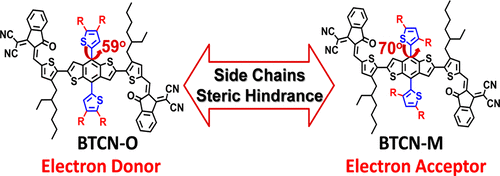当前位置:
X-MOL 学术
›
Chem. Mater.
›
论文详情
Our official English website, www.x-mol.net, welcomes your
feedback! (Note: you will need to create a separate account there.)
Tunable Electron Donating and Accepting Properties Achieved by Modulating the Steric Hindrance of Side Chains in A-D-A Small-Molecule Photovoltaic Materials
Chemistry of Materials ( IF 7.2 ) Pub Date : 2018-01-16 00:00:00 , DOI: 10.1021/acs.chemmater.7b03142 Delong Liu 1 , Liyan Yang 1 , Yang Wu 2 , Xiaohui Wang 2 , Yan Zeng 1 , Guangchao Han 1 , Huifeng Yao 1 , Sunsun Li 1 , Shaoqing Zhang 1 , Yun Zhang 1 , Yuanping Yi 1 , Chang He 1 , Wei Ma 2 , Jianhui Hou 1
Chemistry of Materials ( IF 7.2 ) Pub Date : 2018-01-16 00:00:00 , DOI: 10.1021/acs.chemmater.7b03142 Delong Liu 1 , Liyan Yang 1 , Yang Wu 2 , Xiaohui Wang 2 , Yan Zeng 1 , Guangchao Han 1 , Huifeng Yao 1 , Sunsun Li 1 , Shaoqing Zhang 1 , Yun Zhang 1 , Yuanping Yi 1 , Chang He 1 , Wei Ma 2 , Jianhui Hou 1
Affiliation

|
Modulation of the electron donating and accepting properties of organic semiconductors is an important topic in the field of organic photovoltaics. Although the small-molecule semiconductors (SMs) with an A-D-A structure can act as either electron donor or acceptor in organic photovoltaic (OPV) devices, the reason why molecules with similar conjugated structures play different roles remains unclear. In this work, we designed and synthesized two A-D-A SMs named BTCN-O and BTCN-M, which have an identical backbone and differ in the alkyl substitution position. BTCN-O and BTCN-M demonstrate similar optical absorption spectra in solution and molecular energy levels in a solid film. BTCN-O forms an ordered lamellar packed structure with compact π–π stacking, whereas BTCN-M demonstrates only a weak π–π stacking effect in solid film. We also investigated their photovoltaic properties by blending each with a polymer donor, PBDB-T, and a fullerene acceptor, PC71BM, and found that the electron donating and accepting abilities of BTCN-O and BTCN-M are exactly opposite. According to the results obtained from a variety of analytical methods, we can infer that for the planar A-D-A SMs, the steric hindrance caused by the nonconjugated alkyls in their central units plays a critical role that affects their electron donating and accepting properties. More specifically, the A-D-A molecules that have low steric hindrance in their central units, which allows ordered lamellar packing and compact π–π stacking in the solid film, can act as an electron donor in OPV device, and the molecules that have high steric hindrance for intermolecular π–π interactions in their central units tend to act as electron acceptors. Overall, this work provides a new perspective in the molecular design of organic photovoltaic materials.
中文翻译:

通过调节ADA小分子光伏材料中侧链的立体阻碍来实现可调节的电子给予和接受特性
调节有机半导体的电子给电子和接受性能是有机光伏领域的重要课题。尽管具有ADA结构的小分子半导体(SM)可以充当有机光伏(OPV)器件中的电子供体或受体,但尚不清楚具有相似共轭结构的分子起不同作用的原因。在这项工作中,我们设计并合成了两个名为BTCN-O和BTCN-M的ADA SM,它们具有相同的主链,并且烷基取代位置不同。BTCN-O和BTCN-M在溶液中显示出相似的光吸收光谱,在固体膜中显示出分子能级。BTCN-O形成有序的层状堆积结构,具有紧凑的π-π堆积,而BTCN-M仅在固态膜中表现出较弱的π-π堆积效果。71BM,发现BTCN-O和BTCN-M的给电子和受电子能力正好相反。根据从各种分析方法获得的结果,我们可以推断出,对于平面ADA SM,其中心单元中非共轭烷基引起的空间位阻起着至关重要的作用,影响它们的电子给予和接受性能。更具体地说,在其中心单元中具有低空间位阻的ADA分子可以在固体膜中进行有序的层状堆积和紧凑的π-π堆叠,可以充当OPV器件中的电子供体,而具有高空间位阻的分子因为在它们的中心单元中分子间的π-π相互作用倾向于充当电子受体。总的来说,这项工作为有机光伏材料的分子设计提供了新的视角。
更新日期:2018-01-16
中文翻译:

通过调节ADA小分子光伏材料中侧链的立体阻碍来实现可调节的电子给予和接受特性
调节有机半导体的电子给电子和接受性能是有机光伏领域的重要课题。尽管具有ADA结构的小分子半导体(SM)可以充当有机光伏(OPV)器件中的电子供体或受体,但尚不清楚具有相似共轭结构的分子起不同作用的原因。在这项工作中,我们设计并合成了两个名为BTCN-O和BTCN-M的ADA SM,它们具有相同的主链,并且烷基取代位置不同。BTCN-O和BTCN-M在溶液中显示出相似的光吸收光谱,在固体膜中显示出分子能级。BTCN-O形成有序的层状堆积结构,具有紧凑的π-π堆积,而BTCN-M仅在固态膜中表现出较弱的π-π堆积效果。71BM,发现BTCN-O和BTCN-M的给电子和受电子能力正好相反。根据从各种分析方法获得的结果,我们可以推断出,对于平面ADA SM,其中心单元中非共轭烷基引起的空间位阻起着至关重要的作用,影响它们的电子给予和接受性能。更具体地说,在其中心单元中具有低空间位阻的ADA分子可以在固体膜中进行有序的层状堆积和紧凑的π-π堆叠,可以充当OPV器件中的电子供体,而具有高空间位阻的分子因为在它们的中心单元中分子间的π-π相互作用倾向于充当电子受体。总的来说,这项工作为有机光伏材料的分子设计提供了新的视角。









































 京公网安备 11010802027423号
京公网安备 11010802027423号